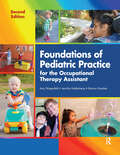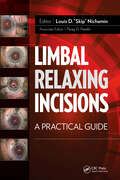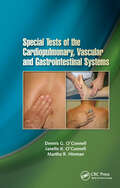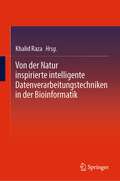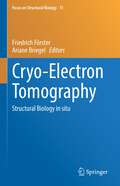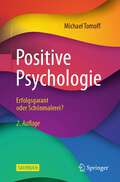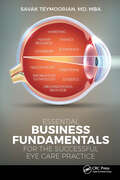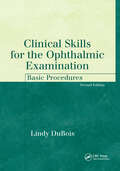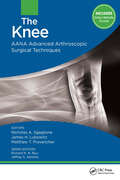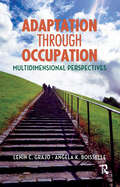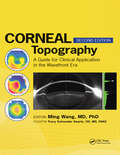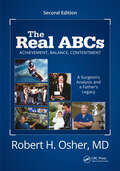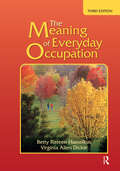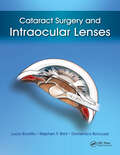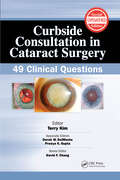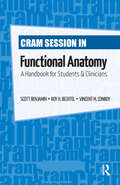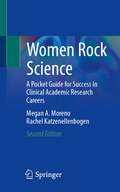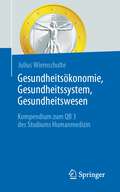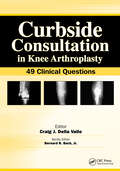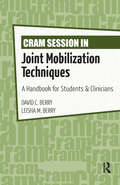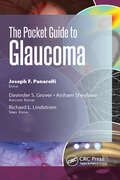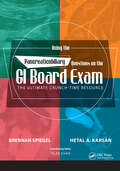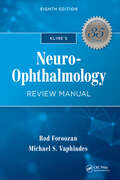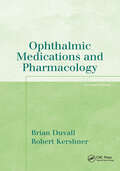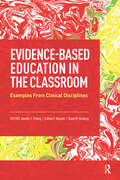- Table View
- List View
Foundations of Pediatric Practice for the Occupational Therapy Assistant
by Amy Wagenfeld Jennifer Kaldenberg DeLana HonakerFoundations of Pediatric Practice for the Occupational Therapy Assistant, Second Edition delivers essential information for occupational therapy assistant students and practitioners in a succinct and straightforward format. In collaboration with a wide range of highly skilled and expert professionals from clinical practice and academia, Amy Wagenfeld, Jennifer Kaldenberg, and DeLana Honaker present an interprofessional perspective to pediatric clinical foundations, theory, and practical application activities in a highly accessible and engaging format.The Second Edition of Foundations of Pediatric Practice for the Occupational Therapy Assistant offers new and engaging features, including diverse illustrations, to facilitate learning from the classroom to the clinic. Integrated within each chapter are Stories From Practice: brief vignettes of actual author clinical experiences, short case studies, and reflective activities designed to elicit discussion and exploration into the unique world of pediatric occupational therapy theory and practice. A new chapter on childhood trauma has been added to enhance the comprehensive and current nature of pediatric practice in the 21st century.Available online is a significant Major Infant Reflexes Chart and a comprehensive Normal Developmental Milestones Chart that will reinforce important concepts associated with child development as it relates to occupational therapy assistant practice. The seamless integration of this material enables all readers to develop a comprehensive understanding of the information and apply that knowledge in a pediatric setting.Features of the Second Edition: Up-to-date information, including the AOTA’s current Occupational TherapyCode of Ethics Stories From Practice feature, which provides a unique reflective link from classroom to clinic Useful resources for classroom to clinical practice Bonus website that provides a comprehensive Normal Developmental Milestones Chart and Major Infants Reflexes Chart Chapter on childhood trauma Included with the text are online supplemental materials for faculty use in the classroom. Foundations of Pediatric Practice for the Occupational Therapy Assistant, Second Edition continues to be the perfect text for both occupational therapy assistant students and practitioners specializing in or transitioning to pediatrics.
Limbal Relaxing Incisions: A Practical Guide
by Louis NichaminFor both surgeon and patient alike, the success of modern implant surgery is increasingly judged by the refractive and astigmatic outcome. In spite of this, there has not yet been a practical book that addresses the process of performing limbal relaxing incisions (LRIs). Dr. Louis D. “Skip” Nichamin and his contributors aim to fill this void with Limbal Relaxing Incisions: A Practical Guide.Limbal Relaxing Incisions serves as a guide for novice refractive implant surgeons looking to incorporate incisional astigmatism surgery into their repertoire. It also contains practical pearls that the more experienced practitioner can use to refine astigmatic refractive outcomes following lens-based surgery.Limbal Relaxing Incisions covers a wide range of information from the history, background, and future of astigmatism management, to important subjects such as measuring cylinder and strategic planning for the surgical correction of astigmatism. Dr. Nichamin and his contributors detail their personal approaches to the use of LRIs, each presenting a slightly different technique and providing simple clinical pearls for both the novice and experienced practitioner. In addition, the book offers a discussion on astigmatic enhancement surgery, potential complications, and insight into the emerging field of Femto-Second Laser technology to further refine and automate astigmatism correction.Residents in ophthalmology, comprehensive ophthalmologists, refractive cataract surgeons, and keratorefractive surgeons taking up lens-based refractive surgery will appreciate the “this is how I do it” approach in Limbal Relaxing Incisions: A Practical Guide, as well as the emphasis on clinical pearls, written by some of the most experienced refractive cataract surgeons in the field.
Special Tests of the Cardiopulmonary, Vascular, and Gastrointestinal Systems
by Dennis O'Connell Janelle O'Connell Martha HinmanOrganized in a user-friendly format, Special Tests of the Cardiopulmonary, Vascular, and Gastrointestinal Systems provides a unique, compact, and concise summary of over 95 special tests and exam procedures.Drs. Dennis O’Connell, Janelle O’Connell, and Martha Hinman have organized Special Tests of the Cardiopulmonary, Vascular, and Gastrointestinal Systems by the different systems and describe each special test in terms of clinician action, normal findings, positive findings, special considerations, and references. Each major body region covered also includes a brief section on its history.Features:• Includes more than 95 different tests and exam procedures such as Respiratory Rate Rhythm, Carotid Artery Auscultation, Ankle-Brachial Index Test, Palpation of Abdominal Organs and Aorta, Two-and Six-Minute Walk Tests, the Talk Test, and Non-Exercise VO2max Tests• More than 125 photographs and illustrations, including “how-to” photographs.• Specific references based upon the latest evidence available.• Includes 6 appendices covering topics such as Maximal Aerobic Power, Treadmill Calibration, and Astrand-Rhyming Nomogram.• User-friendly, spiral, lay-flat binding.In addition to the special tests categories, a submaximal exercise evaluation section has been added for clinicians who believe exercise is an excellent preventive and rehabilitative tool but who may be unfamiliar with the topic.Special Tests of the Cardiopulmonary, Vascular, and Gastrointestinal Systems is a must-have resource for students and clinicians in physical therapy, athletic training, and occupational therapy looking to recall the specifics of a particular test or learning it for the first time.Also serves as a great companion to the popular texts, Special Tests for Orthopedic Examination, Third Edition and Special Tests for Neurologic Examination.
Von der Natur inspirierte intelligente Datenverarbeitungstechniken in der Bioinformatik
by Khalid RazaDieses Buch umfasst und beschäftigt sich mit den jüngsten Fortschritten und modernsten Anwendungen von naturinspirierten Computertechniken (NIC) im Bereich der Bioinformatik und der Computerbiologie, die die medizinischen Wissenschaften bei verschiedenen klinischen Anwendungen unterstützen können. Dieser Sammelband befasst sich mit den grundlegenden Anwendungen, dem Umfang und den Zukunftsperspektiven von NIC-Techniken in der Bioinformatik, einschließlich der Erstellung von Genomprofilen, der Klassifizierung von Genexpressionsdaten, der DNA-Berechnung, der System- und Netzwerkbiologie, der Lösung von Komplikationen bei personalisierten Therapien, der antimikrobiellen Resistenz bei bakteriellen Krankheitserregern und der computergestützten Entwicklung von Arzneimitteln, deren Entdeckung und Therapie. Darüber hinaus wird die Rolle von NIC-Techniken bei verschiedenen Krankheiten und Störungen behandelt, einschließlich Krebserkennung und -diagnose, Brustkrebs, Erkennung von Lungenkrankheiten, Krankheits-Biomarkern und Identifizierung potenzieller Therapeutika.
Cryo-Electron Tomography: Structural Biology in situ (Focus on Structural Biology #11)
by Friedrich Förster Ariane BriegelThis book presents key aspects and recent developments of cryogenic sample electron tomography (cryo-ET) methodology, authored by leading experts in the field. Understanding structure and function of biomolecules in the context of cells is a new frontier in cellular and structural biology. To facilitate such research, cryo-ET is a key method to visualize the molecules of life in their native settings. Cryo-ET enables the imaging of samples that are preserved in a near-native state, at (macro)-molecular resolution and in three dimensions. Thus, this technique is a unique tool to gain insights into how biomolecules collaborate in orchestrating fundamental biological processes, how mutations cause diseases, pathogens cause infections, and to develop novel therapeutics to treat such illnesses. This book provides a unique reference for the emerging field of cryo-ET. The topics covered range from the fundamental principles of imaging to sample preparation, data analysis,and data sharing within the scientific community. It serves as a valuable resource for the next generation of structural biologists, making it suitable both for undergraduate students studying biochemistry, biophysics, and molecular biology and highly valuable for the more experienced and specialized PhD student. Furthermore, it stands as a state-of-the–art source of knowledge for the established senior scientist within the field of structural biology.
Positive Psychologie - Erfolgsgarant oder Schönmalerei?
by Michael TomoffPositive Psychologie - Erfolgsgarant oder Schönmalerei? Entdecken Sie die Doppelkante der Positiven Psychologie: Ein Schlüssel zu mehr persönlichem und beruflichem Erfolg oder doch nur eine rosarote Brille? Diplom-Psychologe Michael Tomoff entführt Sie in eine Welt, die sowohl die glänzenden als auch die schattigen Seiten dieser bewegenden Wissenschaft beleuchtet. Das vorliegende Buch ist weit mehr als ein Glücksratgeber. Es ist eine fundierte, kritische und dennoch humorvolle Untersuchung der Positiven Psychologie, die sich sowohl an Lehrer, Eltern, Führungskräfte, Mitarbeiter, Coaches und auch Trainer richtet – egal ob Laien oder Experten. Mit einem klaren Blick auf die wissenschaftliche Basis und die praktische Anwendung beleuchtet der Autor die Mythen und Missverständnisse rund um die Wissenschaft des Wohlbefindens: Macht Geld glücklich? Sind Eltern zufriedener als Kinderlose? Welche Rolle spielen Schuld und Scham bei der Kindererziehung? Wie kann die Positive Psychologie die Schule oder das Unternehmen von morgen unterstützen und formen? Und sollte sie das überhaupt? Durch die elegante, mundgerechte Zusammenfassung aktueller Forschungen, die Vorstellung leicht umsetzbarer Übungen, Tools und Interventionen sowie die Erörterung der Relevanz der Positiven Psychologie in verschiedenen Kulturen und Lebensbereichen bietet dieses Buch einen umfassenden Überblick und praktische Anleitungen. Erfahren Sie, wie die Positive Psychologie in Schulen, Unternehmen und im persönlichen Leben konkret Anwendung finden kann, und welche Vorteile sie bietet. Michael Tomoff ist nicht nur ein erfahrener Psychologe, sondern auch ein leidenschaftlicher Botschafter für das Potenzial der Positiven Psychologie, das Wohlstand und Wohlbefinden zu fördern und dabei realistisch und kritisch zu bleiben. Mit seiner Ausbildung an der University of California in Berkeley und seiner breiten Erfahrung als Trainer, Berater und systemischer Coach bringt ereine einzigartige Perspektive und eine Fülle von praktischen Einsichten in dieses fesselnde Werk ein. In seinem Blog „Was Wäre Wenn“ gibt er wichtige Impulse zu einer Vielzahl von Themen wie Dankbarkeit, Komplimenten, dem Nein-Sagen, Grenzensetzen oder auch stärkenfokussierter Führung.
Essential Business Fundamentals for the Successful Eye Care Practice
by Savak TeymoorianA compact business education that strategically incorporates 500 keywords to lay the foundation and over 50 action items to initiate meaningful advances and excel in your eye care practice today. Medical training is a difficult journey with enormous amounts of information to absorb over a short time period. The intense time commitment required during this process leaves little opportunity to study any other discipline. However, even the most intelligent and well-intentioned provider cannot care for patients if the front door of the building is closed. Simply put: A fundamental background in business is required to effectively practice medicine. Eye care professionals, which includes their ophthalmic staff, can now fill the critical gap in their education with Essential Business Fundamentals for the Successful Eye Care Practice, providing them the necessary basic tools to make and execute winning practice management decisions. Writing in a high-density format that medical professionals will be familiar with, Dr. Savak Teymoorian combines his physician training and experience as a successful ophthalmologist at Harvard Eye Associates with the knowledge acquired earning his MBA. This unique perspective allows him to provide the proper theory and execution in the business of eye care and present it in an efficient manner like that used in medical education. Each chapter is dedicated to a different subject that would routinely be taught in a masters of business administration degree, tailored specifically for eye care professionals and distilled into the most critical information for a strong foundation. Each section is further enhanced with real life examples seen in ophthalmic care showing how to properly apply business strategies and tactics to obtain the best results.Chapter topics include: Marketing Leadership Negotiations Operations Finance Ophthalmologists, optometrists, and eye care staff will appreciate Essential Business Fundamentals for the Successful Eye Care Practice for its efficient and relevant information to running an eye care practice, whether they are currently in training and want to set themselves up for success or they are already practicing and want to fill in a deficiency in their knowledge.
Clinical Skills for the Ophthalmic Examination: Basic Procedures (The Basic Bookshelf for Eyecare Professionals)
by Lindy DuboisThe step-by-step, instructional guide for the most common ophthalmic instruments and procedures has been updated to a second edition. Clinical Skills for the Ophthalmic Examination: Basic Procedures, Second Edition provides details on tests frequently performed in the office and provides instructions on the proper way to perform them. Lindy DuBois focuses on presenting fundamental instruction in a clear and easy-to-use manual. Essential chapters, such as those on patient history, medications, allergies, and refractive surgery have been updated to offer critical information for the ophthalmic professional. New to this edition: An expanded History section with a detailed patient interview to comply with new regulations. Expanded Interim History section to include patients with low vision. New sections on Exophthalmometry and A-Scan Biometry. Make Clinical Skills for the Ophthalmic Examination: Basic Procedures, Second Edition your go-to text for information on the latest procedures and instruments used in the clinic today.
The Knee: AANA Advanced Arthroscopic Surgical Techniques (AANA Advanced Arthroscopic Techniques series)
by Nicholas Sgaglione James Lubowitz Matthew ProvencherCo-published with the Arthroscopy Association of North America, The Knee: AANA Advanced Arthroscopic Surgical Techniques is a comprehensive technique-based book that presents the latest diagnostic and reconstructive techniques in arthroscopic surgery for the knee.The Knee: AANA Advanced Arthroscopic Surgical Techniques is authored by premier arthroscopic surgeons Drs. Nicholas A. Sgaglione, James H. Lubowitz, Matthew T. Provencher, and their international list of expert contributors. This comprehensive resource includes preferred physical examination testing and diagnostic imaging choices in pre-operative planning and patient selection, state-of-the-art step-by-step description of the procedures, detailed surgical equipment lists to perform each procedure, clear and precise indications for surgery and the thoughtful rationale behind stated contraindications, controversial indications, post-operative protocols, and potential complications.The written text is supported by numerous color images and a website with invaluable, narrated video clips depicting disease-specific arthroscopic techniques specific to the knee.Features inside The Knee: AANA Advanced Arthroscopic Surgical Techniques Narrated video accompanies all surgical techniques, focusing on the stepwise approach to each operation Consistent organization throughout the book results in a bulleted and user-friendly interface for a quick reference or prolonged study Top 5 Technical Pearls for each procedure to enhance outcomes and to avoid common pitfalls and complications High-quality artwork and figures to complement clinical images Equipment and surgical technique checklists for quick reference prior to surgery Each expert contributor was chosen for his or her expertise for a specific topic related to The Knee, so the reader benefits by the highest quality and treatment recommendations to provide state-of-the-art care to his or her patient. Some chapter topics include:-Arthroscopic Reduction and Fixation of Tibial Plateau and Eminence Fractures-Arthroscopic Treatment of Patellar Tendinopathy-Arthroscopic Meniscal Repair-Novel Techniques in Articular Cartilage Restoration -Advances in Anterior Cruciate Ligament Reconstruction
Adaptation Through Occupation: Multidimensional Perspectives
by Lenin Grajo Angela BoisselleAdaptation, as an internal human process, is an often-overlooked construct in occupational therapy education, research, and practice. Adaptation Through Occupation: Multidimensional Perspectives aims to change that by presenting different perspectives that challenge the reader’s understanding of occupational adaptation. As the first of its kind text to explore, analyze, and present a comprehensive and multidimensional approach to understanding occupational adaptation, the collection of writings in this text add to the range of knowledge available in occupational therapy.Adaptation Through Occupation: Multidimensional Perspectives by Drs. Lenin Grajo and Angela Boisselle provides in-depth perspectives of occupation and adaptation that can be used to teach courses on foundational and theoretical perspectives in occupational therapy, occupational science undergraduate and graduate programs, and as a critical module in teaching Neuroscience to occupational therapy students. This text also aims to facilitate new bodies of research to define and apply the concept of adaptation in relation to occupational performance and participation.Some perspectives covered inside include: Historical and theoretical perspectives on occupation and adaptation Neural mechanisms of occupational adaptation Occupational science perspectives and international and lived-experience perspectives Included with the text are online supplemental materials for faculty use in the classroom.Adaptation Through Occupation: Multidimensional Perspectives opens the gates for new ways of understanding occupational adaptation and adds necessary information to the existing knowledge in the occupational therapy profession.
Corneal Topography: A Guide for Clinical Application in Wavefront Era
by Ming WangWith the rapid advancement of corneal topography and wavefront technologies and the increased application of corneal topography not only in refractive but also in premium IOL surgery, a new edition of the best-selling Corneal Topography: A Guide for Clinical Application in the Wavefront Era will be the foremost resource for both ophthalmologists and optometrists. In this Second Edition, Dr. Ming Wang, Dr. Tracy Swartz and over 50 contributors combine the important topics of refractive and premium lens surgeries and put corneal topography in the context of wavefront technology. With over 500 images, this edition gives special attention to the latest advances in these technologies.The state-of-the-art science and application of corneal topography for these anterior segment surgeries is well represented in Corneal Topography, A Guide for Clinical Application in the Wavefront Era, Second Edition, making it the latest and most comprehensive reference of these state-of-the-art technologies for refractive and for premium IOL surgery. Topographic and Wavefront Technologies Covered Include:• Placido disc-based topographic systems• Elevation-based topographic systems• Ultrasound-based topographic systems• OCT-based topographic systems• Topography and wavefront combined systemsTopographic Applications Covered Include:• Topographies of corneal diseases, including post-RK/CK/LASIK/PRK• Topography-guided contact lens fitting• Topography application in refractive surgery and in premium IOL surgeries• Topographic guidance for corneal surgeries• Topography-guided custom treatments• Combined treatment strategies using topography and wavefront data• Future development of corneal topography in the wavefront eraUpdated and reorganized to reflect changes in the technology, Corneal Topography: A Guide for Clinical Application in the Wavefront Era, Second Edition is indispensible for all anterior segment surgeons, ophthalmologists, and optometrists.
The Real ABCs: A Surgeon's Analysis and a Father's Legacy
by Robert H. OsherIn The Real ABCs: A Surgeon’s Analysis and a Father’s Legacy, Second Edition, pioneering cataract surgeon Dr. Robert Osher reflects on his 40-year career and candidly shares that the secret to his professional success and personal happiness lies in the pursuit of “the real ABCs”—achievement, balance, and contentment.Dr. Osher was an internationally renowned surgeon and father of five when he was diagnosed with a pineapple-sized kidney cancer at age 53. Suddenly confronted with his own mortality, he resolved to write his legacy for his family, friends, and colleagues. The result is The Real ABCs, originally published after Dr. Osher’s successful recovery and newly updated with his experiences and wisdom of the last decade—an inspirational story of one man’s achievements as well as a prescriptive guide for finding balance and contentment.In The Real ABCs, Dr. Osher tells the story behind some of his accomplishments in ophthalmology, including the founding of the Cincinnati Eye Institute, the Cataract Surgery: Telling It Like It Is meeting, the Video Journal of Cataract and Refractive Surgery, and the introduction of groundbreaking techniques in cataract surgery. Dr. Osher demonstrates the importance of hard work and enthusiasm while admitting the inevitability of adversity and setbacks, acknowledging that his achievements wouldn’t be possible without the influence of his cherished teachers, mentors, friends, and family. Throughout the book, Osher also stresses the importance of seeking balance, whether it’s through nature, adventure, service, or adherence to one’s principles. The Real ABCs: A Surgeon’s Analysis and a Father’s Legacy, Second Edition is a deeply personal story filled with universal life lessons. Ultimately, Dr. Osher shows that approaching one’s career and personal life with passion and perseverance can help anyone attain a feeling of contentment and success.
The Meaning of Everyday Occupation
by Betty Risteen Hasselkus Virginia DickieNewly updated to address emerging directions in occupational therapy and occupational science, The Meaning of Everyday Occupation, Third Edition encourages occupational therapy personnel—students, educators, researchers, and practitioners—to recognize humans as occupational beings and to understand the meaning and significance of everyday occupation in day-to-day life. Written by award-winning and internationally known authors Drs. Betty Risteen Hasselkus and Virginia Allen Dickie, the Third Edition explores the concept of meaning as it relates to occupation in daily life. Each chapter is augmented by the authors’ personal reflections, narratives from occupational therapists in practice, and quotations from participants in the authors’ occupational research, creating a text in which the concepts and theories of occupation and occupational therapy come alive for the reader. Themes in the Third Edition include: Meaning in everyday life and its occupations Space and place as sources of meaning Culture in everyday occupation and in the context of therapy Well-being and development through everyday occupation Occupation as connection Disability and occupation Occupation and the human spirit Everyday creativity Emphasizing occupation as experience, the comprehensive Third Edition champions the contributions of meaning to a client-centered approach to practice. This brings forward a new understanding of how to therapeutically affect the systems in which we all live and work. The everyday occupation of our lives is often overlooked. By increasing the visibility of everyday occupation, The Meaning of Everyday Occupation, Third Edition offers readers the opportunity for personal reflection on day-to-day occupational patterns. By recognizing and acknowledging these patterns in their own lives, occupational therapy personnel can better understand how day-to-day occupation and disruption of that occupation affects the lives of clients.
Cataract Surgery and Intraocular Lenses
by Lucio Buratto Domenico Boccuzzi Stephen BrintCataract Surgery and Intraocular Lenses offer a detailed overview of intraocular lenses, as the choice of the IOL to be implanted is a critical detail in the patient selection and surgical preparation, and therefore leading to the most optimal patient results. Dr. Lucio Buratto, Dr. Stephen Brint, and Dr. Domenico Boccuzzi present the latest information on the most advanced diagnostic techniques and surgical decisions for IOL selection and implantation. Cataract Surgery and Intraocular Lenses covers a wide variety of topics, including monofocal IOLs, multifocal IOLs, accommodative IOLs, injectors and implantation of foldable IOLs, tear or damage of the IOL, and viscoelastic substances. Supplemented by more than 200 color illustrations, diagrams, a glossary, and references, all surgeons from beginner to expert will want this unique resource by their side.
Curbside Consultation in Cataract Surgery: 49 Clinical Questions (Curbside Consultation in Ophthalmology)
by Terry KimCurbside Consultation in Cataract Surgery: 49 Clinical Questions has been updated into a Second Edition!The Second Edition contains new questions and is completely updated! Curbside Consultation in Cataract Surgery, Second Edition contains new questions and brief, practical, and evidence-based answers to the most frequently asked questions that are posed during a “curbside consultation” between surgical colleagues. Dr. Terry Kim and associate editors Drs. Derek Delmonte and Preeya Gupta have assembled 49 of the top cataract consultants from the U.S. and abroad to offer expert advice, preferences, and opinions on tough clinical questions commonly associated with cataract surgery in this updated reference. The unique Q&A format provides quick access to current information related to cataract surgery in the simplicity of a conversation between two colleagues. Numerous images, diagrams, and references are included to enhance the text and to illustrate surgical pearls. Some of the questions that are answered inside the Second Edition include:• My patient has unreliable topography due to ocular surface pathology. What are my options for treatment and IOL selection?• How do I pick the right IOL formula for my patient with a longer/shorter than average eye?• My capsulorhexis is heading out peripherally. How should I proceed and what should I do if it tears radially?• How/when should I change my phaco/fluidics settings in the following situations: IFIS, shallow chamber, high axial length, post vitrectomy?• I have a radial tear in the anterior capsule. How do I proceed with phaco and IOL implantation?• When should I use a toric intraocular lens versus astigmatic keratotomy/LRI?• How do I incorporate femtosecond (FS) laser into my current cataract surgery techniques?Curbside Consultation in Cataract Surgery: 49 Clinical Questions, Second Edition provides information basic enough for residents while also incorporating expert pearls that even experienced cataract surgeons will appreciate. General ophthalmologists, residents, and cataract specialists alike will benefit from the user-friendly and casual format as well as the expert advice contained within.
Cram Session in Functional Anatomy: A Handbook for Students and Clinicians
by Scott Benjamin Roy Bechtel Vincent ConroyWhen all you need is a basic understanding of the anatomy of the muscular system, supplemented by current evidence and research, Cram Sessions on Functional Anatomy: Applications and Problem Solving for Real-Life Situations is what you will look to for quick, at-your-fingertips facts.Cram Sessions on Functional Anatomy by Drs. Benjamin, Bechtel, and Conroy is a concise and illustrated quick reference that takes over 60 years of combined clinical experience to provide an understanding of the muscular system and its relation to the fascial and ligamentous systems in the human body, providing benefits for improved patient care and streamlined exercise prescription.What is in your Cram Session? Translation of basic anatomy through both clinical expertise and research evidence A unique understanding of the muscular system and its role in health and disease A section on “clinical pearls” for each muscle or group – helping make practical use of the anatomical data, and improving the diagnosis and treatment of common patient problems Over 100 photographs and line art depicting each muscle or group of muscles Cram Sessions on Functional Anatomy: Applications and Problem Solving for Real-Life Situations is a practical, easy-to-read handbook for all students and clinicians involved in physical therapy, athletic training, occupational therapy, and other rehabilitation professions.
Women Rock Science: A Pocket Guide for Success in Clinical Academic Research Careers
by Megan A. Moreno Rachel KatzenellenbogenThe second edition of this book builds on the success of the first edition, which had many unique features including an emphasis on success in context and how women can thrive in today's clinical research environment. In this new edition, Women Rock Science incorporates promoting inclusivity of gender diverse persons, working in the hybrid world since the COVID-19 pandemic, and the value of diversity, equity and inclusion (DEI), with lessons learned from other women scientists, throughout the book. This book provides key strategies and skills around a central conceptual model as well as a sense of community with other women scientists. Clinical academic research is conducted in many forms, and Women Rock Science speaks to lab-based work, clinical work, health services/implementation science, quality improvement, medical education, health equity, and DEI-focused research throughout its chapters. The approaches and insights addressed are not narrowlyfocused on a discipline or a methodology of research. Rather, Women Rock Science addresses how to achieve excellence in research, across disciplines, within an academic institution. Described as the "unwritten rules" of successfully navigating a clinical academic research career, Women Rock Science is a valuable resource that can be used in a variety of settings. It is beneficial for University classes, lab group meetings, and can be shared with one’s community of mentors, mentees and colleagues.
Gesundheitsökonomie, Gesundheitssystem, Gesundheitswesen: Kompendium zum QB 3 des Studiums Humanmedizin
by Julius WiemschulteIm Humanmedizinstudium ist der Querschnittsbereich 3 "Gesundheitsökonomie, Gesundheitssystem und Öffentliches Gesundheitswesen" ein verpflichtender Kurs im klinischen Studienabschnitt, der an allen medizinischen Fakultäten in Deutschland angeboten wird. In diesem Kurs erlernen die Studentinnen und Studenten die Systematik des Gesundheitswesens. Dieses Buch bietet in prägnanter Form die wichtigsten Informationen zum erfolgreichen Absolvieren des QB 3 und deckt die Themenfelder Gesundheitssystem, Öffentliches Gesundheitswesen, Gesundheitsökonomie und Qualitätsmanagement ab. Die klar strukturierten Inhalte werden durch praktische Bezüge zum ärztlichen Arbeitsalltag greifbar, so dass die große Relevanz des Stoffes als Rückgrat der ärztlichen Tätigkeit ersichtlich wird. Verständnisfragen zur Wissensreflektion und Fallbeispiele runden das Kompendium ab. Das Buch richtet sich an Studentinnen und Studenten der Humanmedizin und ist auch empfehlenswert für fachnahe Berufsgruppen (Sozialversicherungsfachangestellte, Gesundheits- und Pflegefachberufe).
Curbside Consultation in Knee Arthroplasty: 49 Clinical Questions (Curbside Consultation in Orthopedics)
by Craig J. Della ValleAre you looking for concise, practical answers to those questions that are often left unanswered by traditional knee arthroplasty references? Are you seeking brief, evidence-based advice for complicated cases or controversial decisions? Curbside Consultation in Knee Arthroplasty: 49 Clinical Questions provides quick answers to the thorny questions most commonly posed during a “curbside consultation” between orthopedic surgical colleagues.Dr. Craig J. Della Valle has designed this unique reference which offers expert advice, preferences, and opinions on tough clinical questions commonly associated with knee arthroplasty. The unique Q&A format provides quick access to current information related to knee arthroplasty with the simplicity of a conversation between two colleagues. Numerous images, diagrams, and references are included to enhance the text and to illustrate the management of the knee.Curbside Consultation in Knee Arthroplasty: 49 Clinical Questions provides information basic enough for residents while also incorporating expert advice that even high-volume clinicians will appreciate. Practicing orthopedists, orthopedic residents, and non-physician personnel will benefit from the user-friendly and casual format and the expert advice contained within.Some of the questions that are answered: I have a patient who has a deformity of the distal femur and arthritis of the knee. Should I do an osteotomy to correct the deformity? If I am doing a total knee arthroplasty and the patella does not seem to track well, what should I do? I am doing a total knee in a patient with a varus deformity. I have done my standard release and the knee is still tight medially. What should I do? What do I do if I cut the MCL intra-operatively? How do you assess joint line position at the time of revision TKA? What are the clinical consequences if it is elevated?
Cram Session in Joint Mobilization Techniques: A Handbook for Students & Clinicians
by David Berry Leisha BerryWhen all you need is a basic understanding of joint mobilization techniques, supplemented by succinct and demonstrative examples, look to Cram Session in Joint Mobilization Techniques: A Handbook for Students & Clinicians for quick, at-your-fingertips facts.Cram Session in Joint Mobilization Techniques by Dr. David C. Berry and Leisha M. Berry is a descriptive quick reference that provides the rehabilitation professional with a detailed yet easy-to-digest approach to joint mobilization techniques. Organized into quick-reference tables and concise descriptions of each technique, this resource offers an efficient way to learn the cognitive and psychomotor skills necessary to competently perform joint mobilization techniques.What is in your Cram Session: Easy-reference tables of joint complex osteology and arthrology Photographs depicting mobilization techniques for each joint Case studies in mobilization Quiz questions to test your knowledge Cram Session in Joint Mobilization Techniques: A Handbook for Students & Clinicians is an informative, well-organized handbook for all students and clinicians in athletic training, physical therapy, occupational therapy, osteopathic medicine, and other rehabilitation professions.
The Pocket Guide to Glaucoma (Pocket Guides)
by Joseph Panarelli Davinder Grover Arsham SheybaniThe Pocket Guide to Glaucoma provides essential information on glaucoma for medical students, residents, fellows, and general ophthalmologists.Drs. Joseph F. Panarelli, Davinder Grover, Arsham Sheybani, and colleagues have designed this book as the ultimate quick-read manual on glaucoma, using a conversational tone that allows readers to retain information in the most effective manner. Medical students, residents, and fellows can use this accessible, high-yield handbook during their rotations to familiarize themselves with the essentials on glaucoma, while general ophthalmologists will be glad to have it as a quick reference guide to current best practices.Each chapter in The Pocket Guide to Glaucoma is arranged in short, easy-to-read sections and is accompanied by numerous color photographs to aid in recognition and retention.Among the topics covered: Optic nerve head imaging Laser procedures for glaucoma Medical therapy for glaucoma Microinvasive glaucoma surgery Traditional glaucoma surgery: pearls and pitfalls Landmark glaucoma trials Eye care providers at all skill levels will benefit from the high-yield, quick-access information contained in The Pocket Guide to Glaucoma, whether they are preparing for their first surgeries or are longtime physicians.
Acing the Pancreaticobiliary Questions on the GI Board Exam: The Ultimate Crunch-Time Resource
by Brennan Spiegel Hetal KarsanThe Pancreas. It’s not very large, but it packs a punch. You gotta know about the pancreas. Then toss in the crazy complexities of the biliary system and there’s is a lot to learn to manage your patients. In this latest book in the Acing GI Board Exam Series, the focus is on the pancreas and biliary tree and how they can cause trouble. In today’s fast-paced world, it is a struggle to keep up with the burgeoning panc-bil literature. Until now, there has been no single, slim, but high-yield volume that summarizes the panc-bil you really need to know for the board exam. This review book keeps you on your toes and sharp for everyday clinical practice too. What is the best way to effectively prepare and study, if reading multiple resources can’t seem to fit into your daily schedule? The answer to your study questions (and study time!) can be found inside Acing the Pancreaticobiliary Questions on the GI Board Exam: The Ultimate Crunch-Time Resource. Dr. Brennan MR Spiegel and Dr. Hetal A. Karsan have collected every pearl of wisdom, high-yield factlet, panc-bil "board buzzword," and classic imaging study they could muster, all while keeping Acing thePancreaticobiliary Questions on the GI Board Exam a manageable size. Why You Will Need to Read Acing the Pancreaticobiliary Questions on the GI Board Exam: Carefully vetted board-style clinical vignettes with color images Comprehensive yet succinct answers using a high-yield format Emphasis on key clinical pearls and “board buzzwords” Answers to classic board “threshold values” questions that you need to know but always seem to forget Rapid-fire, crunch-time exam with 150 classic one-liners Acing thePancreaticobiliary Questions on the GI Board Exam fills the unmet need in board review by presenting time-tested and high-yield information in a rational, useful, and contextually appropriate format suitable studying for the board exams and preparing for the recertification exam. Chapters Include: A compilation of general lessons learned from past test-takers “Tough Stuff” board review vignettes Board review “Clinical Threshold Values” “Crunch-Time” Self-Test and Answer Guide—time to get your game on! With its focus on pearl after pearl, emphasis on images, and attention to high-yield “tough stuff” vignettes you don’t know the answers to (yet), Acing the Pancreaticobiliary Questions on the GI Board Exam is truly the ultimate crunch-time resource for acing the GI board examination, taking recertifying examinations, looking good on clerkship rounds, or for just challenging yourself with interesting and entertaining vignettes.
Kline's Neuro-Ophthalmology Review Manual
by Rod Foroozan Michael VaphiadesFor over 35 years, Kline’s Neuro-Ophthalmology Review Manual has presented a unique and user-friendly approach to address clinical neuro-ophthalmology principles used in everyday practice. This Eighth Edition continues that tradition, providing a timely update, while also maintaining the same user-friendly and concise format. Dr. Rod Foroozan and Dr. Michael Vaphiades have taken the mantle of updating this respected manual from Dr. Lanning Kline and continue his tradition of a simple summary of the most important clinical aspects of neuro-ophthalmology with schematic illustrations and material relevant to everyday practice. They are joined by their contributing authors, all seasoned neuro-ophthalmologists, and have organized the book to provide the essential key information on neuro-ophthalmic disorders. The Eighth Edition provides a comprehensive update to the latest information, adds many new effective exercises for case study, and is a complete update on neuro-ophthalmic conditions, including results of recent clinical trials and emerging literature. Also new is the inclusion of a table of neuro-ophthalmic emergencies which serves as a quick guide so that these potentially life-threatening and blinding conditions can be accessed easily.Chapters include: Nystagmus and Related Ocular Oscillations Myasthenia and Ocular Myopathies Nonorganic Visual Disorders Disorders of Higher Visual Function Neuroimaging Kline’s Neuro-Ophthalmology Review Manual, Eighth Edition has all the fundamentals presented logically for all practitioners and residents in ophthalmology, neurology, and neurosurgery. A popular choice among colleagues for more than 35 years, this a must-have resource in neuro-ophthalmology.
Ophthalmic Medications and Pharmacology (The Basic Bookshelf for Eyecare Professionals)
by Brian Duvall Robert M. KershnerFor those who are new to the subject, ocular pharmacology can be a difficult and sometimes overwhelming topic. Ophthalmic Medications and Pharmacology, Second Edition is a reader-friendly guide that provides a quick review and basic clinical reference of ocular pharmacology.In this updated and revised second edition, Drs. Duvall and Kershner present an overview to the medication and drugs found most commonly in ophthalmic practice without overwhelming those professionals new to the subject. Ophthalmic Medications and Pharmacology concisely reviews commonly used and prescribed medications, how they work, dosage, therapeutic use, and potential side effects. This new edition also highlights key information for patients about the medications they encounter and are prescribed in the clinic.Ophthalmic staff, students, and research professionals looking for an introduction and basic go-to guide will welcome having a copy of Ophthalmic Medications and Pharmacology by their side.New to this edition:· An appendix focused on the drug approval process.· A chapter on retinal therapies.· Study icons to assist in the learning process.· New coverage of vasoconstrictors.
Evidence-Based Education in the Classroom: Examples From Clinical Disciplines
by Jennifer Friberg Colleen Visconti Sarah GinsbergEvidence-Based Education in the Classroom: Examples From Clinical Disciplines shows educators how to use evidence to inform teaching practices and improve educational outcomes for students in clinically based fields of study.Editors and speech-language pathologists Drs. Jennifer C. Friberg, Colleen F. Visconti, and Sarah M. Ginsberg collaborated with a team of more than 65 expert contributors to share examples of how they have used evidence to inform their course design and delivery. Each chapter is set up as a case study that includes: A description of the teaching/learning context focused on in the chapter A brief review of original data or extant literature being applied A description of how evidence was applied in the teaching/learning context Additional ideas for how evidence could be applied in other teaching/learning contexts across clinical disciplines Additional resources related to the pedagogy described in the case study (e.g., journal articles, books, blogs, websites) Educators in the fields of speech-language pathology, audiology, nursing, social work, sports medicine, medicine, dietetics, dental assisting, physician assisting, radiology technology, psychology, and kinesiology—already familiar with evidence-based practice—will find this resource helpful in implementing evidence-informed approaches to their teaching.While the content in clinical programs is quite different, there are many similarities in how to teach students across such programs. Evidence-Based Education in the Classroom: Examples From Clinical Disciplines highlights these similarities and represents a masterclass in how to practice evidence-based education.
